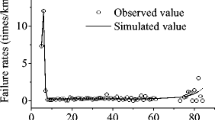Abstract
In this paper, we analyze failure data registered in a water supply network in order to evaluate the pipes failure probability. Only failures in normal operation conditions have been considered, excluding those caused by abnormal events. We consider an observation window from year 2000 until 2005, although the life of some of the water pipes started far in the past. This sampling scheme induces left-truncation into the data set (since failures before 2000 are not considered into the sample information) and right-censoring (for pipes that fail after 2005). We used an extended version of the Nelson–Aalen estimator, modified in order to accommodate left-truncation besides right-censoring (LTRC). Influencing factors on water pipes survival are identified. By the use of a semiparametric model based on the Cox proportional hazards model, also adapted to manage left-truncated and right-censored data, the effect of each factor over the failure risk of a pipe section has been estimated.
Similar content being viewed by others
References
Andreou S (1987) Maintenance decisions for deteriorating water pipelines. J Pipelines 7:21–31
Andreou SA, Marks DH, Clark RM (1987a) A new methodology for modelling break failure patterns in deteriorating water distribution systems: theory. Adv Water Resour 10:2–10
Andreou SA, Marks DH, Clark RM (1987b) A new methodology for modelling break failure patterns in deteriorating water distribution systems: applications. Adv Water Resour 10:11–20
Christodoulou S, Deligianni A (2010) A neurofuzzy decision framework for the management of water distribution networks. Water Resour Manag 24:139–156
Debón A, Carrión A, Cabrera E, Solano H (2010) Comparing risk of failure models in water supply networks using ROC curves. Reliab Eng Syst Saf 95:43–48
Debt AK, Hasit Y, Grablutz JFM, Hertz RK (1998) Quantifying future rehabilitation and replacement needs of water mains. AWWA Research Foundation, Denver
Eisenbeis P (1994) Modélisation statistique de la prévision des défaillances sur les conduites d’eau potable. Ph.D. thesis, University Louis Pasteur of Strasbourg, collection Etudes Cemagref no. 17
Gustafson JM, Clancy DV (1999) Modelling the occurrence of breaks in cast iron water mains using methods of survival analysis. In: Proceedings of the AWWA annual conference, Chicago
Herz RK (1996) Ageing processes and rehabilitation needs of drinking water distribution networks. J Water Supply Res Technol Aqua 45:221–231
Herz RK (1998) Exploring rehabilitation needs and strategies for water distribution networks. J Water Supply Res Technol Aqua 47:275–283
Mailhot A, Duchesne S, Musso E, Villeneuve JP (2000) Modélisation de l’évolution de l’état structural des réseaux d’égout : application à une municipalité du Québec. Can J Civ Eng 27:65–72
Malandain J (1999) Modélisation de l’état de santé des réseaux de distribution d’eau pour l’organisation de la maintenance. Etude du patrimoine de l’agglomération de Lyon. Ph.D. Dissertationt no. 99 ISAL 0040. Institut National des Sciences Appliquées de Lyon, Laboratoire URGC/Hydrologie Urbaine, 206 p
Malandain J, Le Gauffre P, Miramond M (1999) Modeling the aging of water infrastructure. In: Proceedings of the 13th EJSW, Dresden University of Technology
Pan W, Chappell R (1998) A nonparametric estimator of survival functions for arbitrarily truncated and censored data. Lifetime Data Anal 4:187–202
Park S, Kim BJ, Im GC (2008) Modeling of water main failure rates using the log-linear ROCOF and the power law process. Water Resour Manag 22:1311–1324
Sægrov S, König A et al (2001) Evaluation of UtilNets—a decision support systems for water mains rehabilitation. In: Proceedings of the IWA international conference in Brno, Czech Republic
Solano Hurtado H (2008) Análisis de Supervivencia en Fiabilidad. Predicción en condiciones de alta censura y truncamiento: el caso de las redes de suministro de agua potable. Ph.D. Dissertation, Universidad Politécnica de Valencia, Spain
Therneau TM, Gramsch PM (2000) Cox modeling survival data. Extending the model. Springer, New York
Tsai WY, Jewell NP, Wang MC (1987) A note on the product-limit estimator under right censoring and left truncation. Biometrika 74:883–886
Turnbull BW (1976) The empirical distribution function with arbitrarily grouped, censored and truncated data. J R Stat Soc B 38:290–295
Author information
Authors and Affiliations
Corresponding author
Rights and permissions
About this article
Cite this article
Carrión, A., Solano, H., Gamiz, M.L. et al. Evaluation of the Reliability of a Water Supply Network from Right-Censored and Left-Truncated Break Data. Water Resour Manage 24, 2917–2935 (2010). https://doi.org/10.1007/s11269-010-9587-y
Received:
Accepted:
Published:
Issue Date:
DOI: https://doi.org/10.1007/s11269-010-9587-y




